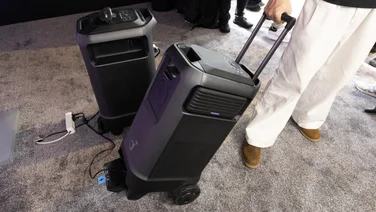To help us provide you with free impartial advice, we may earn a commission if you buy through links on our site. Learn more

Efficiency and low power are the two bywords that Intel is using for its future development. For a more intelligent mobile future, where our devices are full of sensors, it’s clear that low power is going to be incredibly important in order to maintain battery life. What we consider low power today and what we’ll need it to be are two completely different things, as Intel demonstrated at IDF 2013. During Dr Genevieve Bell’s keynote, she talked about a future where our mobile devices are more intelligent and really know us. For this future to happen, she said that “if we want to have mobile technology that doesn’t burden us down, that knows us, it turns out we’re going to need to have really, really low power”. Mike Bell, general manager of the new devices group at Intel, was then brought on stage with his assistant, Chuck, to demonstrate exactly what the company meant by low power: a computer powered by a glass of wine. In a similar way to how a potato or lemon can be used to power a clock or a light, Intel wanted to show that a glass of wine could be used to power its silicon. The process for a potato or a glass of wine is the same: a cathode (a positive terminal made from copper) and an anode (a negative terminal made of zinc) are placed into a conductive solution (acid, in this case wine), allowing ions to travel between the two surfaces. The result, when using wine, is a trickle of power. “So I have a little development board here, and on here, I’ve got a low-power communication solution, a low-power processing solution, and an accelerometer, right?” said Chuck. “Now, when I talk about low power, you might be thinking low power in that 1-watt, 2-watt solution you’d find in a phone. “Well, today, we’re not here to talk about watts. We’re not even here to talk about milliwatts. We’re here to talk about microwatts.” The demonstration then showed a laptop with two windows on it: one empty and one a rendered image of a flower. Chuck explained how if his development board had power it would transmit data from an accelerometer to the computer, which would animate the flower accordingly. He then hooked the development board up to the wine battery to demonstrate how extremely low power allowed processing and communication. “Now, if you take a look on that empty screen, now that my development board has power, you see accelerometer data being transferred, encapsulated from the processor, sent to the computer, and it’s showing up here,” said Chuck. “Now, if I pick up this development board and I move that around, you will see that orchid starting to reference just like my reference board here. So you can see I’m powering my entire computing solution from what was left over from last night’s dinner.” More tantalisingly Intel mentioned how future devices could even be powered “with the heat of our skin”, meaning a dedicated power source and battery wouldn’t technically be needed. Intel is hoping that truly low-power components can usher in a new era of truly personal computing, with wearable computers.
“We’re really entering this year…of very personal computing,” said Mike Bell. “We’ve been talking about it for years, but there’s nothing more personal than electronics you wear, right? So no one wants to have to rush home to charge their clothing or charge their devices. I mean, we’re talking about running some of these devices on a coin cell for weeks or months at a time.”






